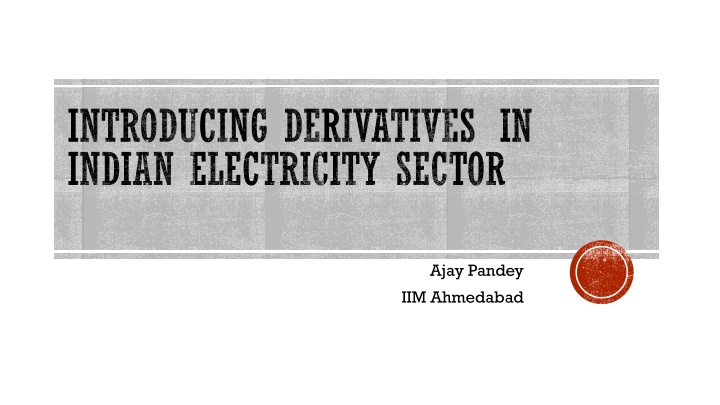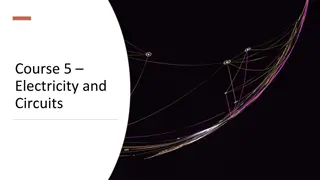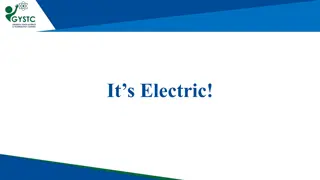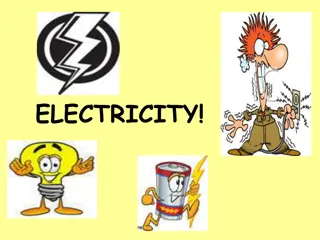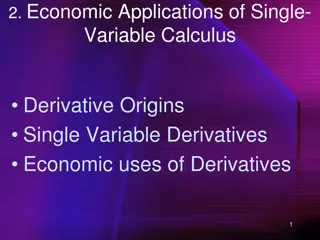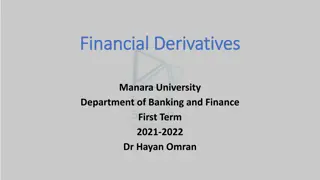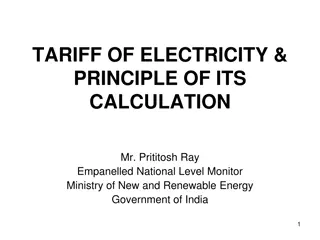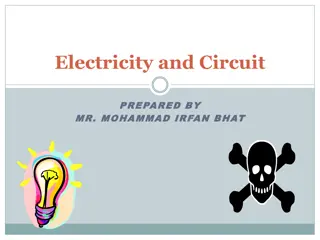Potential of Derivatives in Indian Electricity Sector
The Indian electricity sector, post the enactment of EA 2003 and unbundling, has relied heavily on long-term power purchase agreements and bilateral contracts. However, limitations exist, such as lock-ins and default risks. Introducing derivatives could mitigate these risks, provided the necessary conditions like a liquid spot market and active participation are met. Electricity derivatives have unique characteristics, being unable to store long-term quantities. Overall, there is potential for derivatives to enhance market efficiency in the Indian electricity sector.
Download Presentation

Please find below an Image/Link to download the presentation.
The content on the website is provided AS IS for your information and personal use only. It may not be sold, licensed, or shared on other websites without obtaining consent from the author.If you encounter any issues during the download, it is possible that the publisher has removed the file from their server.
You are allowed to download the files provided on this website for personal or commercial use, subject to the condition that they are used lawfully. All files are the property of their respective owners.
The content on the website is provided AS IS for your information and personal use only. It may not be sold, licensed, or shared on other websites without obtaining consent from the author.
E N D
Presentation Transcript
INTRODUCING DERIVATIVES IN INDIAN ELECTRICITY SECTOR Ajay Pandey IIM Ahmedabad
THE CONTEXT After enactment of EA 2003 and unbundling of the sector, most of the electricity purchased by the distribution companies from generators has been through long- term power purchase agreements from generators and bilateral short/medium term contracts. The electricity markets (offering day-ahead, intra-day, real-time, and term-ahead contracts) currently account for a small part of the market for dispatch (~ 3-4%?). At the ISTS (inter-state transmission system) level, SCED (security constrained economic dispatch) has been implemented. SCED uses the contracted energy price for dispatch. The plan was to move towards MBED (market based economic dispatch), which is yet to be implemented.
KNOWN LIMITATIONS OF THE BILATERAL CONTRACTS INSTEAD OF MARKET . The bilateral contracts create a lock-in between the buyer and seller and if any party wants to get out of its obligations then the other party has to agree (for a price) and if that doesn't happen, then there is a risk of dispute and default. In such a case recourse to legal enforcement has to be taken by the objecting party. If the effect of lock-in is sought to be undone by any of the two parties by entering into an offsetting (opposite side, buy for a sell or sell for a buy) contract with another counter- party , then the entity is exposed to another counter-party risk with which it has entered into offsetting contract. Long-term bilateral contract in large quantity of asset or commodity increases the risk of default by any of the two counter-parties due to unwillingness or inability to fulfil its obligations. If that risk is reduced by allowing price variation, then the price risk cannot be mitigated. If there exists a liquid market in the electricity market, then the problems of lock-in, managing counter-party risks, and cost of disputes and contract enforcement can be taken care of through traded derivatives such as futures and options
SPECIAL CHARACTERISTICS OF ELECTRICITY DERIVATIVES Unlike other asset of commodity markets in which derivatives are traded, electricity can not yet be stored for long-term in large quantities and hence the linkage between spot prices and futures/forward price is not driven by cost-of- carry. In other words, the electricity derivatives may result in price discovery for the prices expected in the future by the market participants somewhat delinked with the spot prices.
NECESSARY CONDITIONS FOR INTRODUCING DERIVATIVES . The reference/spot market, usually day-ahead, should be liquid for the hedgers (end-users) and speculators to feel confident about the price for settlement. Currently, we don t have a single market for dispatch even at the ISTS level. Currently, market coupling is being discussed but a full-fledged MBED could be a starting point. The derivative market itself should be liquid so that no one can influence the price. This will require active participation not only from users but others particularly large financial institutional players. That will improve the nature of price discovery , more information gathering on factors likely to affect demand and supply, and also act as an informal surveillance mechanism on attempt to manipulate market.
DERIVATIVES: FURTHER CONSIDERATIONS . The regulators (CERC/SEBI) need to jointly develop a surveillance mechanism to prevent market manipulation either directly or through related parties. This may require framing disclosure requirement and regulations. On surveillance, SEBI has experience from financial markets whereas CERC has the experience of the sector and information on sector-specific manipulation possibilities (economic or physical withholding). It is also important for the regulatory stance in the sector for power purchase costs to change so that the discoms are not penalized for hedging using derivatives. Currently, the stance is to pass on the contracted prices for physical delivery to be accepted as the allowed power purchase costs. With the use of derivatives, the cost of hedging has to be dealt with by the regulators. Finally in order to increase the liquidity and most economic dispatch, the PPAs with physical delivery obligations should be treated as financial contracts for energy prices and the transmission open access for long-term, medium-term and short-term should be done away with.
